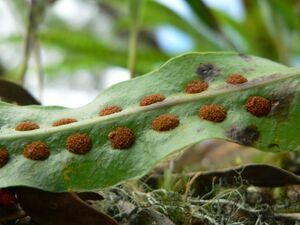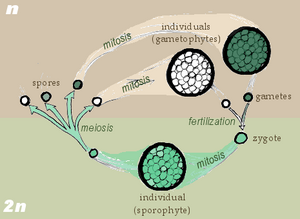Spore: Difference between revisions
No edit summary |
No edit summary |
||
| Line 1: | Line 1: | ||
[[Image:Fern spores P1180804.jpg|thumb|Fern sori, clusters of meiosporangia on the underside of the leaf]] | [[Image:Fern spores P1180804.jpg|thumb|Fern sori, clusters of meiosporangia on the underside of the leaf]] | ||
[[Image:Sporic meiosis.png|thumb|Spores produced in a sporic life cycle.]] | [[Image:Sporic meiosis.png|thumb|Spores produced in a sporic life cycle.]] | ||
A simple reproductive body, usually composed of a single detached cell, and containing no [[embryo]].{{SCH}} | A simple reproductive body, usually composed of a single detached cell, and containing no [[embryo]].{{SCH}} | ||
{{Inc| | |||
Spore, a reproductive detached cell of a cryptogamous or so-called flowerless plant, not containing an embryo as does a seed. Spores are the reproductive bodies of ferns, mosses, club-mosses, liverworts, fungi, and similar plants. They are of interest to the plant- grower mostly as the means of propagating ferns. For description, see Ferns and Fungi; also the articles on Mildew, Rust, and Smut. For propagation by spores, see the discussion under [[Ferns]]. | |||
}} | |||
{{glossary}} | {{glossary}} | ||
Latest revision as of 23:40, 17 July 2009


A simple reproductive body, usually composed of a single detached cell, and containing no embryo.CH
| Standard Cyclopedia of Horticulture |
|---|
|
Spore, a reproductive detached cell of a cryptogamous or so-called flowerless plant, not containing an embryo as does a seed. Spores are the reproductive bodies of ferns, mosses, club-mosses, liverworts, fungi, and similar plants. They are of interest to the plant- grower mostly as the means of propagating ferns. For description, see Ferns and Fungi; also the articles on Mildew, Rust, and Smut. For propagation by spores, see the discussion under Ferns.
|
| This article contains a definition from the Glossary of Gardening Terms. |